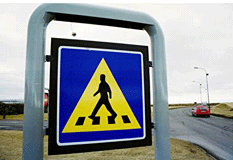LLI Master's Thesis LLI Overview Location Linked Information Proposal Location Linked Information Introductory Presentation (PowerPoint) |
Location Linked Information
The Location Linked Information system proposes the creation of a scalable architecture to support the access and creation of Location Linked Information-the coupling of physical location with arbitrary virtual information nuggets. The proposed system dynamically links a physical space/time moment with a distributed database containing information that describes that moment's surroundings. This hybrid virtual/physical space, called glean space, is owned, managed, and rated by the public, for the benefit of the populace. Imagined as initially being embodied by an interactive, dynamic map viewed on a handheld computer, the system provides two functions for its urban users: 1) the retrieval of information about their surroundings, and 2) the optional annotation of location for communal benefit. It is our hypothesis that Location Linked Information will enhance the urban experience, just as access to transportation dramatically altered the sensation and form of the city. By making inhabitants hyper-aware of their surroundings, they get the benefits of the small town citizen (omniscience of space and society) whilst possibly being situated in a much larger megalopolis with the social mobility and features that go with it. MOTIVATION The city of bits forgot about its atoms As ubiquitous computing moves from theory to practice, the once-clear demarcation between the virtual and the real worlds is increasingly difficult to visualize, especially when visiting real-world mainstays such as urban streets. The deployment of (invisible) wireless networking technologies such as Wi-Fi and GPRS in these outdoor arenas is accelerating the permeation of digital data; but meaningful applications are noticeably lacking from hybrid digital/physical landscapes [46]. One possible reason for the lag in socially useful, augmented environments is a void in the technical glue that ties together the digital and physical worlds. This thesis suggests one such implementation that maps physical space to virtual data and, in so doing, creates a toolset that technologists, the professionals of location [45], and inhabitants themselves can use to significantly impact urban life [22]. The Dark and Stormy Night: A Possible Usage Scenario It is a dark and stormy night. You are walking home from a stressful day at the office. The weather is so horrible that you duck under an overhang, pull out your PDA, and tap on the "Janus Map Browser" button to see if there is anything you can glean about the vicinity from the digital annotation map. Viewing the simple version of the map (as apposed to the 3-dimensional binocular Janus you use as a tourist), you see a plan of your current location with nearby streets surrounded by a flood of tiny multi-colored dots of various levels of translucency that make the map look like a Seurat painting. The legend in the corner tells you that various colors are used to identify the type of information-with classifications that vary from location identification to historical text for tourists to alerts and public warnings. A click of a dot follows the link to more information. As you let go of the display filter switch you are shown only locations with activities-all the other marks and comments disappear. Most of the information includes things you have done before, but one bright circle a few blocks away labeled "Open Yoga Tonight" interests you enough to click on it. Your PDA then shows you the class schedule and after reading other people's annotation nuggets in the area around the entrance to the yoga center, you decide to take this opportunity to explore this unknown part of your neighborhood. After clicking on one of the annotations you realize that it is not really a yoga participant's comment as it says it is, but Location Spam-an advertisement for the Starbucks across the street. You quickly correct the classification and demote its relevance so others in your position will not have to look at it. Before leaving the dry safety of the overhang, you set an alert message for any of your friends who happen to walk by the overhang to join you at the local oxygen bar afterwards to complete your evening of fun. On your way through the new streets, your Janus satisfies your curiosity by showing you all the apartments that are available for rent on the street, but you decide that it is too expensive of an area. Directly before arriving at the street of the Yoga Center you begin to feel uneasy and change the Janus view to show a video feed from a web cam that a resident has pointed outside his window, which reassures you that the area is safe and it is just the rain and your overactive nerves at work. |
 |
|
Matt Mankins Home Page |
|||